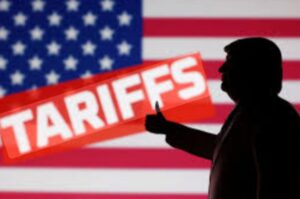US Inflation Rises to 2.7% : Are Higher Prices Just Beginning?
In June 2025, US Inflation Rises to 2.7%, marking the second month in a row of rising costs for American families.
This jump comes just months after President Trump’s new tariffs on imports began, and economists say this may only be the beginning.
Let’s break down what this means for your wallet, and why experts are getting concerned.
US Inflation Rises to 2.7%: What It Means for You
The Consumer Price Index (CPI), which tracks the prices of things like food, clothes, and furniture, shows that prices have risen 2.7% over the past year.
That’s a big jump from earlier this year—and higher than the Federal Reserve’s goal of 2%.
While wages are still growing a little faster than inflation, meaning many people are not feeling the full pinch yet, economists say the warning signs are clear.
Everyday Items Getting Costlier as US Inflation Rises
The rising prices are being felt most in categories where new tariffs have been applied.
Tariffs are taxes on imported goods—and when businesses pay more to bring in products, they often pass those costs on to shoppers.
In June, toys, furniture, and home appliances all saw price increases. Even simple things like tomatoes are getting more expensive.
In fact, the U.S. just placed a 17% tariff on Mexican tomatoes, which means your grocery bill could go up even more soon.
Meanwhile, some categories like air travel and concert tickets have become cheaper, possibly because people are spending less due to economic uncertainty.

US Inflation Rises While Washington Plays a Risky Game
Inside the White House, officials are watching inflation rise—and they know it’s partly their doing.
According to economists, these price hikes aren’t caused by wars or oil shortages. Instead, they’re happening because of policy decisions made right at home.
Former White House economist Jason Furman says this inflation is different. “All of this is happening because of the tariffs the administration decided to put in place,” he explained. “They’re raising prices on purpose, thinking it helps U.S. businesses. But it also hurts consumers.”
Tomatoes to Tea: US Inflation Rises With Tariffs on Everyday Goods
President Trump’s tariff policy is hitting a long list of goods from around the world.
Items affected include not only tomatoes, but also bananas, coffee, tea, and mangoes—most of which the U.S. doesn’t grow in large amounts.
That means Americans will simply pay more for these products, without any real benefit to U.S. farmers or companies.
In some cases, these tariffs are meant to help American growers compete with cheaper imports. But there’s a catch: many farmers are now struggling to find workers, since immigration enforcement has also tightened.
So even if U.S. farmers get a price boost, they may not have enough help to grow or harvest their crops.

US Inflation Rises and Global Trade Tensions Grow
Other countries are not standing still. The European Union is preparing to strike back with tariffs of their own, possibly as early as August. Their targets include popular American exports like bourbon, soybeans, and pasta—a move that could hurt U.S. farmers and manufacturers.
Even though the White House insists inflation won’t reach consumers, prices are already climbing, and a trade war could make things much worse. That would hurt not only shoppers, but also workers in industries that rely on exports.
Confusing Signals from Washington as US Inflation Rises to 2.7%
President Trump recently claimed that trade deals are already done, calling signed letters “the deals.” But just one day earlier, his top economic adviser said negotiations are still happening, and tariffs are being used to pressure other countries.
This mix of messages has created confusion for businesses. Many companies rushed to buy goods before tariffs started, which helped avoid some price jumps—but now that stock is running low, prices may rise quickly.
US Inflation Rises While Allies Turn Elsewhere
There’s another risk: the rest of the world is getting tired of U.S. trade policies.
Countries like France, Japan, and China have their own voters to please. They’re not eager to give in to U.S. demands—and some are now making new trade deals without the U.S..
This means America could lose out on global trade opportunities, and U.S. businesses may find it harder to compete abroad.
Will Inflation Keep Rising? What Comes Next?
Right now, many people haven’t fully felt the impact of rising inflation. But experts warn that this may just be the “calm before the storm.”
If more tariffs go into effect—and if other countries strike back—prices could continue rising in the months ahead.
We’ve already seen the early signs: more expensive toys, appliances, and produce. And it’s not just about shopping—inflation affects the whole economy. It can impact job growth, investment, and interest rates.
Conclusion: US Inflation Rises and Households Should Be Ready
At 2.7%, inflation might not seem scary. But when it rises because of government policies—especially tariffs—it becomes a much bigger concern.
Tariffs may protect certain industries, but they also raise prices for everyone.
As we move into the second half of 2025, one thing is clear: when US inflation rises, it hits families, businesses, and the economy as a whole.
Whether it slows down or continues to grow will depend on the decisions being made in Washington—and how the rest of the w.orld responds.
For now, Americans should watch closely. The full impact of these tariffs may not be felt yet—but it’s coming
Read Also: Epstein Files explained
